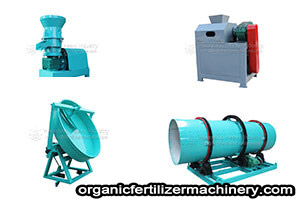Granulation is the core step in organic fertilizer production, directly determining the particle shape, strength, solubility, and storage stability of the product. It is also a crucial node in the organic fertilizer production line, connecting raw material processing and finished product processing. To ensure quality control in the granulation process, the following key points should be emphasized to lay a solid foundation for subsequent screening, packaging, and other processes.

Raw material pretreatment is a prerequisite for successful granulation. The moisture content of the fermented organic fertilizer raw materials must be controlled between 30% and 40%. Too high a moisture content can lead to particle clumping, while too low a moisture content makes it difficult to form qualified particles. Simultaneously, the raw materials must be crushed to a particle size ≤3mm to avoid large impurities affecting the operation of the organic fertilizer granulation machine. The C/N ratio in the raw materials must also be balanced to prevent nutrient imbalance from affecting particle formation.
Equipment debugging and maintenance are essential. Before starting the machine, check the wear of key components such as the granulator's stirring paddle and granulation disc (or extrusion roller) to ensure uniform gaps and flexible rotation. This is also an important measure to extend the service life of the organic fertilizer machine. Different granulation processes (disc granulation, drum granulation, etc.) require adjustments to relevant parameters: disc granulation requires controlling the inclination angle at 45°-60° and the rotation speed at 15-25 r/min; extrusion granulation requires adjusting the pressure to a suitable range to avoid overly loose granules or equipment overload.
Precise control of process parameters is crucial. During granulation, the granule moisture content must be monitored in real time and dynamically adjusted using spray humidification or ventilation dehumidification to ensure a granule formation rate ≥90%. Simultaneously, the granule diameter must be controlled within 2-5 mm, which can be achieved by adjusting the screen size or granulator rotation speed. Furthermore, the residence time of the material within the granulator must be uniform to avoid localized over-extrusion or under-forming.
Quality monitoring and timely adjustments are essential throughout the entire process. Regular sampling tests of granule compressive strength are required; the acceptable standard is ≥2.5 kg/granule, preventing breakage and pulverization during storage and transportation. If problems such as uneven granule size or severe adhesion occur, the moisture content of the raw materials, equipment parameters, or material ratios must be promptly investigated and adjusted to ensure product consistency.
Safety and environmental protection must be implemented simultaneously. The granulation process generates a small amount of dust, requiring the dust removal equipment to be turned on and operators to wear protective masks. During equipment operation, avoid any improper operation and regularly check the electrical and oil systems to prevent mechanical failures or safety accidents. At the same time, promptly clean any residual materials inside the equipment to prevent spoilage and ensure product quality.